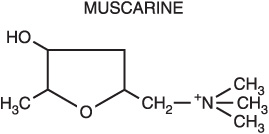ACh degradation: ACh is hydrolyzed by the enzyme acetycholinesterase into acetate and choline.
The two receptors types are nicotinic and muscarinic.
Nicotinic receptors stimulate autonomic ganglia and skeletal muscle. These receptors are also activated by the nicotine alkaloid.

Muscarinic receptors stimulate end-organ receptors. These receptors are also activated by the alkaloid muscarine.

Cholinergic Pharmacology: Clinical Aspects
Normal muscle action: Neuromuscular transmission depends on the release of ACh from presynaptic neurons and activation of postsynaptic nicotinic cholinergic receptors on the motor end plate.
Nondepolarizing muscle relaxants: Neuromuscular transmission is blocked by nondepolarizing muscle relaxants that bind to postsynaptic nicotinic cholinergic receptors.
Reversal of Nondepolarizing Muscle Relaxants
• Spontaneous reversal: Occurs with gradual diffusion, redistribution, metabolism, and excretion of nondepolarizing muscle relaxants.
• Pharmacologic reversal: Occurs with the administration of specific reversal agents. Reversal with acetylcholinesterase inhibitors should be monitored with a peripheral nerve stimulator. At least one twitch with train-of-four (TOF) stimulation should be present before reversal. Suggested endpoints for recovery are sustained tetanus for 5 s in response to a 100-Hz stimulus in anesthetized patients, an adequate TOF ratio greater than 0.9 as assessed by acceleromyography, or sustained head or leg lift in awake patients.
Organophosphates are used in ophthalmology and pesticides. They irreversibly bind to cholinesterase inhibitors.
Side effects of acetylcholinesterase inhibitors: In addition to increasing the availability of acetylcholine at the neuromuscular junction, inhibition of acetylcholinesterase can increase cholinergic receptor activity elsewhere, leading to side effects.
• Cardiovascular system: The predominant muscarinic effect on the heart is a vagal-like bradycardia that can progress to sinus arrest.
• Pulmonary receptors: Muscarinic stimulation can result in bronchospasm and increased respiratory secretions.
• Cerebral receptors: Physostigmine is a cholinesterase inhibitor that can cross the blood–brain barrier (BBB). It can cause diffuse activation of the electroencephalogram by stimulating muscarinic and nicotinic receptors within the central nervous system (CNS).
• Gastrointestinal receptors: Muscarinic stimulation increases peristaltic activity (esophageal, gastric, and intestinal) and glandular secretions (e.g., salivary, parietal). Perioperative bowel anastomotic leakage, nausea and vomiting, and fecal incontinence have been attributed to the use of cholinesterase inhibitors.

Full access? Get Clinical Tree





